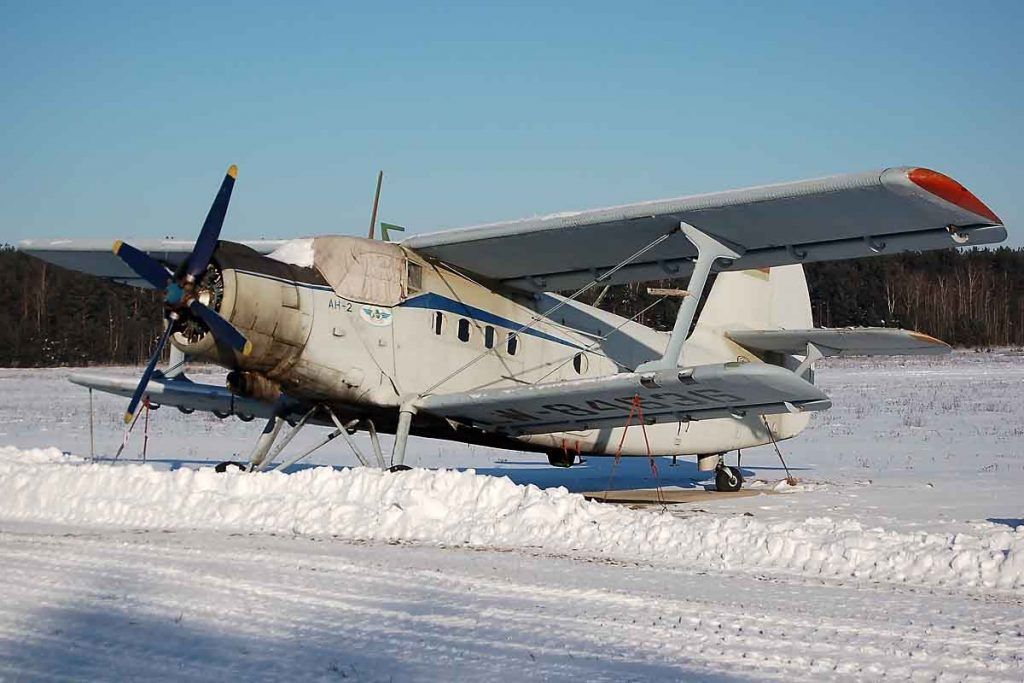The next frontier in drone warfare? A Soviet-era crop duster
By Benjamin Fogel, Andro Mathewson | February 10, 2021
 An An-2 parked in the snow. Credit: www.ariliners.net via Wikimedia Commons. CC BY-SA 3.0.
An An-2 parked in the snow. Credit: www.ariliners.net via Wikimedia Commons. CC BY-SA 3.0.
In September 2020, on the second day of the six-week war between Armenia and Azerbaijan over the disputed Nagorno-Karabakh enclave, the Armenian defense forces published a video of one of their units deploying a surface-to-air missile system to target a low-flying, slow-moving object—a drone. But what the soldiers shot down was no cutting-edge autonomous weapon: They had destroyed a propeller-driven, single-engine biplane first produced in the 1940s by the former Soviet Union for agricultural monitoring and management—a crop duster.
Azerbaijan had evidently converted multiple Antonov An-2 piston-powered light aircraft into uninhabited aerial vehicles. During the conflict, they were repeatedly dispatched on munitions-laden suicide missions used to bait Armenian air defenses. Deployed as a so-called “bait drone,” the An-2 from the September video forced the Armenians to fire their anti-aircraft weapons at its uninhabited fuselage, a ruse which revealed their defensive positions to Azerbaijani commanders searching for vulnerable targets. In doing so, Azerbaijan showed the world that even legacy hardware like the An-2 could be repurposed and used effectively in drone warfare—another example of how militaries continue to find innovative ways to employ increasingly autonomous systems.
Others will likely imitate Azerbaijani bait-drone tactics in future conflicts. These types of drones can be effective tools for exposing an adversary’s locations and capabilities while simultaneously diverting attention from a mission’s primary objectives. They are also cost-efficient, considering that the price of using a bait drone could amount to simply losing an aging clunker like the An-2. Importantly, by repurposing what had been an inhabited plane into a semi-autonomous vehicle, Azerbaijan has also highlighted a weak point in international efforts to slow military drone proliferation.
Earlier today, the Air Defense Units of the #Artsakh Defense Army hit an #Azerbaijan’i AN-2 aircraft, used as a drone in the eastern direction. pic.twitter.com/nQtkihztZ0
— Artsakh Defense Forces (@Karabakh_MoD) October 12, 2020
The bait drones of Nagorno-Karabakh. The Soviet Union originally designed the An-2 in 1946 as a utility aircraft primarily used for crop dusting. The airplane’s popularity stemmed from its easy handling and low maintenance requirements. It could be easily modified to meet a user’s needs. These attributes, of course, also make the An-2 a strong candidate for bait-drone conversion. In the 1950s, the An-2 entered mass-production in the Soviet Union, Poland, and China and has seen extensive service ever since. But, by the time of last autumn’s fighting in Nagorno-Karabakh, the common perception of the aircraft was that it was largely obsolete, particularly for combat. Azerbaijan confounded that belief and used the An-2 to locate Armenian air defense positions and identify equipment its forces could target.
Azerbaijan repeatedly sent the An-2 on one-way, dual-purpose missions to bait Armenian air defenses and act as a cheap alternative to other loitering munitions, the ordinance-bearing kamikaze drones that “loiter” above a target before swooping down to attack. The Nagorno-Karabakh media reported images and videos of downed An-2s, some with large, unexploded bombs, suggesting that Azerbaijan often outfitted the drones with munitions. This was likely intended to guarantee that the Armenian side fired at the bait, lest they became the targets of a lethal attack.
Engineers supporting Azerbaijani forces likely converted the An-2s into drones by installing pneumatic autopilot guidance systems. (While pilots could have been manually setting their aircrafts’ courses before parachuting to safety, there are no credible reports of that happening during the conflict.)
Azerbaijan, in effect, built on previous efforts to make drones out of An-2s. In 2018, China successfully demonstrated the capability to convert the aircraft into an uninhabited cargo plane; Azerbaijan took a different path and repurposed the vehicles for combat.
While we don’t know how many An-2s were used as bait drones, the number could be substantial. In late-August 2020, just weeks before the outbreak of the war over Nagorno-Karabakh, commercial satellite imagery depicted approximately 60 An-2s at Yevlakh airfield in Azerbaijan. That large inventory dates back until at least 2016, but by the end of the first week of fighting in Nagorno-Karabakh, more than half of those An-2s had departed Yevlakh. As the Armenian-backed enclave’s ministry of defense began to publicize this new drone threat, open-source research documented at least 11 Azerbaijani An-2s destroyed during the war.
The An-2 "UAV's" fleet at #Yevlakh Airport #Azerbaijan is very active. August 28th, 2020, 61 aircraft could be counted on the ground whereas October 3rd, 2020 only 26 aircraft could be spotted. It is unknown how many were destroyed and how many are currently flying. #GEOINT pic.twitter.com/YJmgJzTDai
— The Intel Lab (@TheIntelLab) October 4, 2020
Azerbaijan is not the first country to use bait drones in conflict.
During the 1982 Lebanon War, Israeli drones were used to bait Soviet-built, Syrian air defense systems by tricking the systems into thinking they were tracking American-made Israeli fighters. A few years later, the South African Air Force deployed bait drones in the Border War against Cuban and Angolan guerillas. And even the United States employed its own bait drones to great success in the Gulf War against Iraqi air defenses. In each case, bait drones were used to the same effect: They drew the attention of adversarial air defenses, exposed the type and location of anti-aircraft systems being used, and rendered them vulnerable to strikes by artillery fire or dedicated attack aircraft.
The Azerbaijani use of the An-2, however, shows an original and economical utilization of old equipment in a decisively modern and technologically advanced regional conflict. Other militaries, especially in states with an abundance of aging and antiquated Soviet hardware, will likely follow Azerbaijan’s lead. As drones and other modern military technologies become increasingly important in conflict, those nations unable to keep up with recent developments and expensive machinery will undoubtedly make use of equipment on hand, even more so when their results might be as lucrative as those achieved by Azerbaijan.
A future of more modifications and proliferation. Unlike inhabited aircraft, drones are regulated under the Missile Technology Control Regime, a voluntary multilateral export control system that attempts to limit their proliferation. Azerbaijan’s An-2s highlight a loophole in the regime; the system doesn’t prohibit the transfer of the technology or techniques required to turn inhabited aircraft into drones. Although some argue that drones are implicitly covered by the Arms Trade Treaty, it is unlikely to affect such proliferation as the language is too vague and many of the top drone-producing countries—including the United States, Russia, Turkey, and Israel—are not parties. While there haven’t yet been any reports of modified aircraft sales—perhaps because these modifications represent a new policy issue—other countries, or even subversive plotters, could potentially use their own modified aircraft as bait drones, as Azerbaijan did, or even in kamikaze-style terrorists attacks.
In the 40 years since the first widespread use of drones in a traditional military conflict, drones have become increasingly powerful and sophisticated tools for intelligence, surveillance, targeting, reconnaissance, and combat. Today, commercial companies are making drone technology more accessible, and militaries and other armed groups will continue to devise novel uses of drones. Drawing lessons from Azerbaijan’s successes in the conflict, Iran, for example, has increased its investment in loitering munitions, as have NATO air forces such as the Netherlands. Bait drones could be the next.
Azerbaijan’s use of bait drones illustrates how simple automation can transform tactics, techniques, and procedures in modern warfare. While the soldiers in the Nagorno-Karabakh video were able to destroy the An-2 with surface-to-air missiles, they were forced to take Azerbaijan’s bait, increasing their vulnerability to attack. Fundamentally, military planners will have to find new ways to respond to the bait drone threat, while more broadly, the arms control community will have to weigh just how to restrict the new drones as well as the technology required to produce them.
The views expressed in this article are those of the authors and do not necessarily reflect the official position of The HALO Trust.
Together, we make the world safer.
The Bulletin elevates expert voices above the noise. But as an independent nonprofit organization, our operations depend on the support of readers like you. Help us continue to deliver quality journalism that holds leaders accountable. Your support of our work at any level is important. In return, we promise our coverage will be understandable, influential, vigilant, solution-oriented, and fair-minded. Together we can make a difference.
Keywords: Missile Technology Control Regime, Nagorno-Karabak, drones
Topics: Disruptive Technologies















